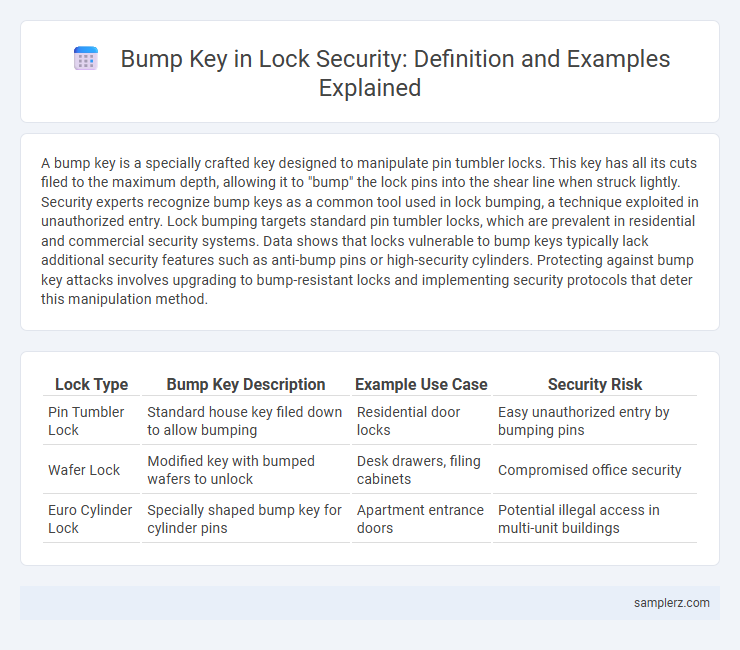A bump key is a specially crafted key designed to manipulate pin tumbler locks. This key has all its cuts filed to the maximum depth, allowing it to "bump" the lock pins into the shear line when struck lightly. Security experts recognize bump keys as a common tool used in lock bumping, a technique exploited in unauthorized entry. Lock bumping targets standard pin tumbler locks, which are prevalent in residential and commercial security systems. Data shows that locks vulnerable to bump keys typically lack additional security features such as anti-bump pins or high-security cylinders. Protecting against bump key attacks involves upgrading to bump-resistant locks and implementing security protocols that deter this manipulation method.
Table of Comparison
| Lock Type | Bump Key Description | Example Use Case | Security Risk |
|---|---|---|---|
| Pin Tumbler Lock | Standard house key filed down to allow bumping | Residential door locks | Easy unauthorized entry by bumping pins |
| Wafer Lock | Modified key with bumped wafers to unlock | Desk drawers, filing cabinets | Compromised office security |
| Euro Cylinder Lock | Specially shaped bump key for cylinder pins | Apartment entrance doors | Potential illegal access in multi-unit buildings |
Understanding the Bump Key Technique in Lock Security
The bump key technique exploits standard pin tumbler locks by using a specially crafted key that fits multiple locks and applies a sudden force to align pins, allowing unauthorized entry. This method poses significant security risks as it bypasses traditional lock mechanisms without visible damage or the need for complex tools. Understanding this vulnerability is crucial for enhancing lock security measures, such as upgrading to bump-resistant locks or employing electronic access controls.
How Bump Keys Work: A Step-By-Step Process
Bump keys operate by aligning the pins inside a lock cylinder to the shear line when a key is struck or "bumped," allowing the lock to turn and open. The process begins with inserting a specially cut key into the lock, then applying a sudden force with a bump hammer or similar tool while simultaneously turning the key. This technique temporarily displaces the pins, bypassing the lock's security mechanisms without the original key.
Common Locks Vulnerable to Bump Key Attacks
Common locks vulnerable to bump key attacks include pin tumbler locks, wafer locks, and certain padlocks, which rely on spring-loaded pins easily manipulated by a bump key. These locks can be compromised in seconds by a skilled attacker using a specially cut key that applies a sudden impact to align the pins and unlock the mechanism. High-security locks with anti-bump features, such as spool pins or sidebar mechanisms, provide enhanced protection against such intrusion methods.
Real-World Examples of Bump Key Incidents
In 2019, a surge of break-ins in urban areas was linked to bump key use, presenting challenges for law enforcement agencies worldwide. Hotels and rental properties experienced frequent unauthorized entries when criminals exploited common pin tumbler lock vulnerabilities using bump keys. These incidents prompted manufacturers to develop bump-resistant locks, emphasizing the critical need for advanced security solutions in real-world scenarios.
The Anatomy of a Typical Bump Key
A typical bump key is cut to have all six pins at the maximum depth, enabling it to align precisely with the pins inside a pin tumbler lock when struck. The key's notches are engineered to transfer kinetic energy from the bump to the pins, causing them to briefly jump above the shear line and allowing the cylinder to turn. Crafted from durable materials such as brass or steel, bump keys exploit the mechanical vulnerabilities in standard lock pin configurations, making them a common tool in unauthorized entry scenarios.
Legal Implications of Bump Key Possession and Use
Possession and use of bump keys are regulated under various jurisdictions due to their potential for unauthorized entry and burglary. In many regions, carrying or employing bump keys without explicit permission can result in criminal charges, including trespassing or possession of burglary tools. Security professionals must remain informed about local laws to ensure compliance and avoid legal consequences related to bump key handling.
Security Flaws Exploited by Bump Keys
Bump keys exploit security flaws in pin tumbler locks by aligning pins at shear lines through rapid impact, allowing unauthorized access without traditional lock picking skills. These keys take advantage of standardized lock designs and inadequate anti-bumping mechanisms, posing significant risks to residential and commercial security systems. Enhanced lock technologies such as spool pins and bump-resistant cylinders mitigate vulnerabilities by disrupting pin alignment during bumping attempts.
Prevention: How to Protect Locks from Bump Key Attacks
High-security locks with anti-bump pins significantly reduce the risk of bump key attacks, making unauthorized entry more difficult. Reinforced lock cylinders and restricted keyways further prevent the insertion and manipulation of bump keys. Regularly upgrading locks to models tested against bump picking standards enhances overall security and resilience against this common attack method.
High-Security Lock Alternatives to Traditional Pin Locks
High-security lock alternatives such as disc detainer locks and tubular locks drastically reduce vulnerability to bump key attacks, which are common in traditional pin tumbler locks. These lock types employ complex mechanisms that resist conventional lockpicking and bumping techniques, enhancing physical security. Implementing these advanced locks significantly mitigates unauthorized access risks in residential and commercial properties.
Industry Response to the Bump Key Threat
Security experts and lock manufacturers have developed high-security locks with anti-bump features to counteract the bump key threat. Industry standards now emphasize bump-resistant technologies such as modified pin tumbler designs and electronic locking mechanisms. Training programs for locksmiths increasingly include awareness and mitigation techniques specific to bump key vulnerabilities.

example of bump key in lock Infographic
 samplerz.com
samplerz.com